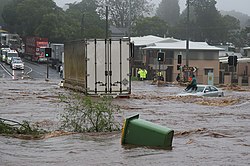
Urban flooding is the inundation of land or property in cities or other built environment, caused by rainfall or coastal storm surges overwhelming the capacity of drainage systems, such as storm sewers. Urban flooding can occur regardless of whether or not affected communities are located within designated floodplains or near any body of water. [1] It is triggered for example by an overflow of rivers and lakes, flash flooding or snowmelt. During the flood, stormwater or water released from damaged water mains may accumulate on property and in public rights-of-way. It can seep through building walls and floors, or backup into buildings through sewer pipes, cellars, toilets and sinks.
Contents
- Causes
- Links to climate change
- Impacts
- Economic impacts
- Modeling
- Localized models
- Modeling of climate change impacts
- Mitigation and management
- Building gray infrastructure
- Using green infrastructure
- Improving drainage systems
- Understanding and altering land use
- Integrated urban water management
- Examples
- By country or region
- United States
- See also
- References
There are several types of urban flooding, each with a different cause. City planners distinguish pluvial flooding (flooding caused by heavy rain), fluvial flooding (caused by a nearby river overflowing its banks), or coastal flooding (often caused by storm surges). Urban flooding is a hazard to both the population and infrastructure. Some well known disaster events include the inundations of Nîmes (France) in 1998 and Vaison-la-Romaine (France) in 1992, the flooding of New Orleans (United States) in 2005, and the flooding in Rockhampton, Bundaberg, Brisbane during the 2010–2011 Queensland floods in Australia, the 2022 eastern Australia floods, and more recently the 2024 Rio Grande do Sul floods in Brazil.
In urban areas, flood effects can be made worse by existing paved streets and roads which increase the speed of flowing water. Impervious surfaces prevent rainfall from infiltrating into the ground, thereby causing a higher surface run-off that may by higher than the local drainage capacity. [2] The effects of climate change on the water cycle can also change the severity and frequency of urban flooding. This applies in particular to coastal cities which may be affected by sea level rise and higher rainfall intensity. [3] : 925
To reduce urban flooding, city planers can use for example the following approaches: building gray infrastructure, using green infrastructure, improving drainage systems, and understanding and altering land use. In general terms, integrated urban water management can help with reducing urban floods.





